In 1848 Sacramento pioneer John Sutter set up a mill for processing timber on the American River near Coloma. On January 24 James Marshall, a foreman working on the construction of the mill, found pieces of shiny material in the tailrace. He took them to Sutter, and tests showed that they were gold. Sutter decided to keep quiet as he feared a gold rush could sweep away his plans for the New Helvetia agricultural empire. Rumours spread and in March the finding of gold was confirmed by San Francisco newspaper publisher and merchant Samuel Brannan. News travelled slowly in those days and it took many months to reach the east coast and even longer to travel abroad. Come 1849 the news had travelled far and people were flocking to California in search of gold. They were called the 49ers and the California Gold Rush had arrived. The first five pictures on this page were taken in 2007 when we travelled from Jamestown up to Marshall Gold Discovery State Historic Park. In 2018 we decided to visit some of the more northerly towns, starting with Paradise on September 27. On November 8 Paradise was destroyed by the Camp Fire, the worst wildfire ever to hit California. 85 people died in the fire. In memory of Paradise and those who lost their lives there we have added pictures of the Gold Nugget Museum and Honey Run Covered Bridge, both of which were destroyed by the Camp Fire.
Main Street, Angels Camp
Henry and George Angel had been soldiers during the Mexican American war, but when they tried prospecting in 1848 they found that they were not cut out for it. On the basis that there was often more money to be made selling supplies to prospectors than there was in prospecting, they set up a trading post. By 1849 there were around 4,000 miners camped around their trading post and the place was given the name Angels Camp. The town has another claim to fame, for it was here in 1865 that Mark Twain heard the story on which he based ‘The Celebrated Jumping Frog of Calaveras County’. Each year in May a Jumping Frog Jubilee is held at the nearby Calaveras County Fairgrounds.
Gold Country
Reconstruction of Sutter's Sawmill, Marshall Gold Discovery State Historic Park
This is where it all started, well nearly. The original Sutter’s Mill has long gone, but there is a monument marking the site and the tailrace is still visible. The discovery of gold triggered the biggest mass movement of people in the Western Hemisphere. The area was overrun with 49ers so, sadly, the chances of finding gold now are slim. The Marshall Gold Discovery State Historic Park has been set up to preserve the site and the remains of the town of Coloma. This reconstruction of Sutter’s Mill stands close to the river but not on the original site.
North Washington Street, Sonora
It was Mexican miners who first arrived here in 1848, and they named the place after their home state of Sonora. Gold was found and by 1851 the population of the town had grown to around 5,000 people. In 1850 Sonora became the county seat of the newly established Tuolumne County, a role that it retains today. It is a busy town with a population still in the region of 5,000. In this picture, St James Episcopal Church can be seen on the left, built in 1860 over the abandoned workings of the Bonanza Mine.
Fall foliage, Main Street, Sutter Creek
The Sierra Nevada Goldfields stretched north and south of the town of Coloma. State authorities have thoughtfully designated the road through the former goldfields as Route 49, so it is easy to find and explore main towns. John Sutter sent men here in 1846 in search of timber, so in 1848 the local creek was named after him. During the gold rush much gold was found round the mining camp of Sutter Creek, but it was the discovery of quartz in 1851 the secured the long term future. Sutter Creek became a town in 1854 and it boomed. Mining continued until World War II when the mines closed to release men for the war effort. Attempts to reopen the mines after the war were short lived. The centenary of the golf rush in 1949 developed tourist interest in the town’s Gold Rush heritage and its classic Old West facades. The facades are still there and behind them you will find numerous tourist shops and restaurants.
Click on Minimap to navigate
Home > US States > The West > California >
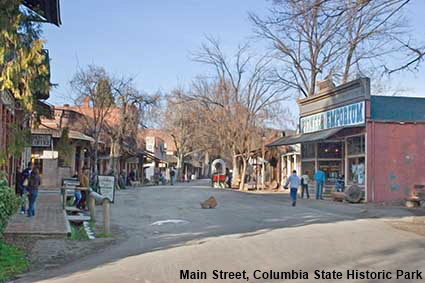
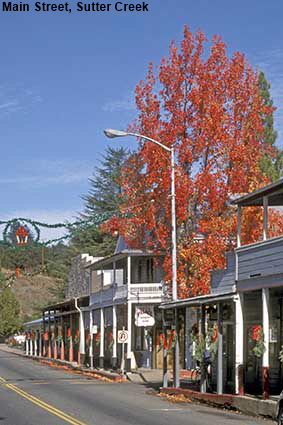
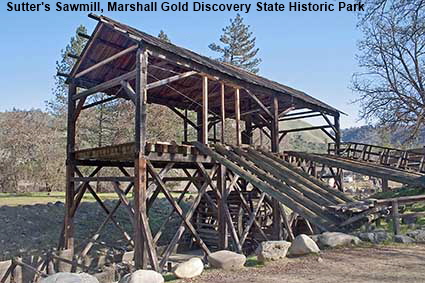
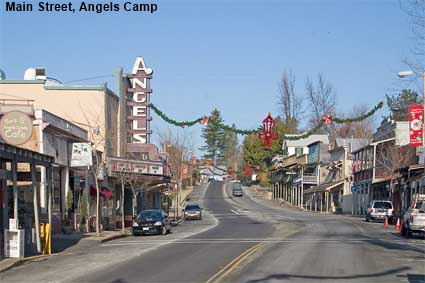
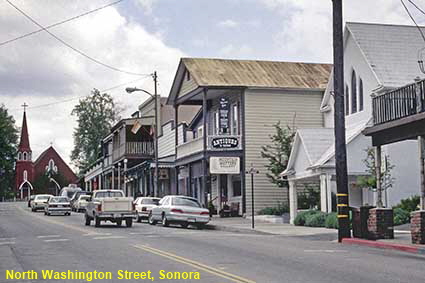
Sierra Railway Shay Locomotive no 2, Railtown 1897, Jamestown
Jamestown is yet another Gold Rush era town full of interesting old buildings but it also has something very different, the Railtown 1897 State Historic Park. Here an authentic railroad roundhouse is the centrepiece of a museum that contains some unusual locomotives. The Shay locomotive shown here was designed to operate on lines with sharp bends. Its bogies are driven by a system of shafts and gears on one side of the locomotive so the boiler is off centre to equalise the weight. Railtown 1897 operates steam excursions in season and has often been used in movies. Click Tab 2 to see another Railtown 1897 treasure, a Hetch Hetchy Railroad Rail Charabanc.
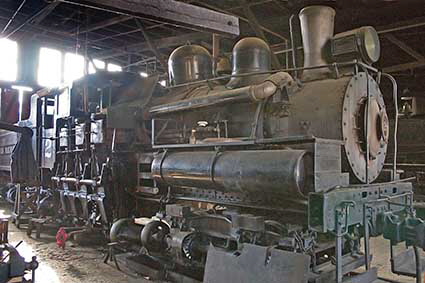
Main Street, Columbia State Historic Park
Columbia was a little late joining the Gold Rush. In March 1850 Dr. Thaddeus Hildreth, his brother and a handful of other prospectors made camp near here and found gold. A town soon sprang up and within ten years it had a population of around 6,000 people. After 1860 the gold began to run out and people started to drift away. Empty buildings were torn down to mine their plots for gold, but the decline continued and the population fell to about 500. Columbia just about managed to keep going and in 1945 Columbia State Historic Park was set up to preserve what was left of this genuine gold rush town. You can walk round the town at any time, but the shops are only open business hours. Click Tab 2 to see the Stagecoach passing Matelot Miners Supply.

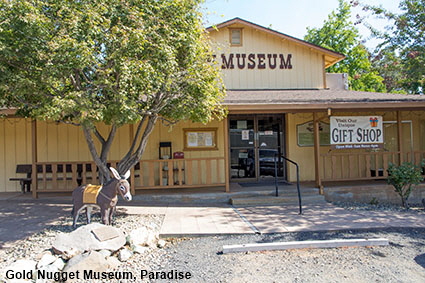
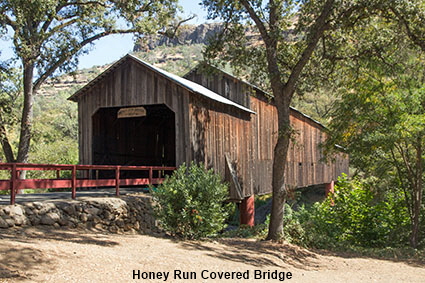
Gold Nugget Museum, Paradise
This is one of the saddest entries in 50 plus DC. In late September 2018 we visited the town of Paradise, stopping at the Gold Nugget Museum where we were given a great welcome and a guided tour by one of the docents. Just six weeks later the town of Paradise was virtually destroyed when the Camp Fire swept through the area. 85 people died in the fire. The intensity of the wildfire made finding and identifying victims a very slow process. The Gold Nugget Museum was totally destroyed in the fire and we do not know the fate of the people that we met there. Here, in memory of the now destroyed town and those who lost their lives, we have posted a photograph of the exterior of the museum prior to its destruction and a couple of shots taken inside the museum and its grounds. There are plans to rebuild the museum but for the time being the Depot Museum which escaped the fire is the temporary location of the Gold Nugget Museum. Click Tab 2 to see Nuggetville (preserved buildings from Paradise’s early days as a gold town) or click Tab 3 to see an unusual 1909 Brush One Cylinder Car that was on display inside the museum.
Honey Run Covered Bridge, near Paradise
Another victim of the Camp Fire was the Honey Run Covered Bridge, about 10 km (6 miles) from Paradise. It was opened in 1887 to provide access to the gold fields on Paradise Ridge. The original bridge was open sided but in 1901 it was covered to protect it from water damage. It served the community well until 1965 when it was damage by a runaway truck. The county decided to replace the bridge with a new one further upstream. Following completion of the new bridge the county planned to tear down the old covered bridge, but the local community had other ideas. Led by Harley Johnson and Dr. Merritt Horning they set up the Honey Run Covered Bridge Association which preserved the bridge and in 1972 opened a park alongside it. The future of the bridge seemed secure until on November 8, 2108 it was totally destroyed by the Camp Fire. These pictures were taken just six weeks before the fire, after the fire only the red metal supports remained. The good news is that reconstruction work is under way and should be completed in 2025. Click Tab 2 to see the interior of the old bridge which was available to rent for events such as weddings.


To move forwards or backwards through the California trail click the arrows above, or select your next destination on the Minimap.
DLU250113

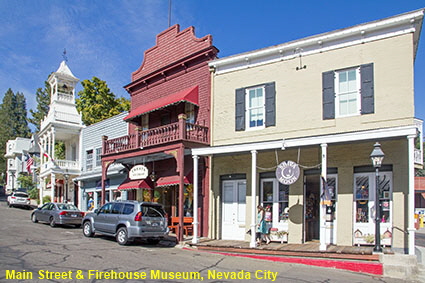
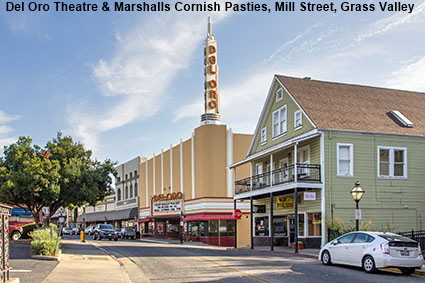
Main Street & Firehouse Museum, Nevada City
In 1849 reports circulated of miners pulling a pound of paydirt a day from gold deposits along Deer Creek and in no time the town of Deer Creek Dry Diggin had sprung up on its banks. In 1850 the town was renamed Nevada. In 1864 the town became Nevada City to avoid confusion with the state of that name. In 1876 a narrow gauge railroad opened connecting Nevada City to the Central Pacific Railroad at Colfax. US President Herbert Hoover worked in the town as a mining engineer for 2 years after he graduated in 1895. When the gold began to run out Nevada City went into decline. The railroad was dismantled in 1942 by which time the city was run down with many buildings boarded up. It was saved in the 1960s and 1970s by hippies who moved in and opened businesses in the derelict buildings. The city leaders realised that these businesses and and preservation of its historic buildings could make Nevada City a tourist destination. Today Nevada City has a population of more than 3,000. Its historic buildings house of quirky shops and museums such as the Firehouse Museum. Outside of town the Nevada City Narrow Gauge Railroad Museum preserves relics from the railroad including a working railbus that provides trips in season. Click Tab 2 to see the Nevada City Narrow Gauge Railroad Museum with Nevada County Narrow Gauge Railroad Locomotive No 5 taking centre stage. No. 5 was built in 1875 at the Baldwin Locomotive Works in Philadelphia
Del Oro Theatre & Marshalls Cornish Pasties, Mill Street, Grass Valley
In 1850 miners panning along Wolf Creek not far from Nevada (City) made a major discovery of gold-bearing quartz and their settlement was briefly named Boston Ravine then Centerville. In 1851 it was renamed Grass Valley. Early settlers had referred to the area as ‘the grassy valley’ and it is thought that this was the origin of the name. Grass Valley became the home of deep mines such as Empire Mine and North Star Mine which ware among the riches mines in California. These mines attracted skilled in miners from Cornwall in England. The narrow gauge railroad arrived in 1876 connecting Grass Valley to Nevada City and Colfax. The mines kept Grass Valley prosperous well into the 20th century with the Art Deco Del Oro Theatre opening in 1942. The Empire and North Star mines closed in 1957 following a miners strike. Both have now become museums. The Empire Mine State Historic Park has preserved much of its mine equipment, the mine offices, clubhouse and owners cottage. The Cornish heritage of Grass Valley remains strong, Marshalls Cornish Pasties is the building on the right in this picture. Sadly, Cousin Jack Pasties closed in 2018 shortly before our visit. Click Tab 2 to see a view across the Mineyard at Empire Mine State Historic Park.
© Mike Elsden 1981 - 2025
The contents of this page may not be reproduced in full or in part without permission